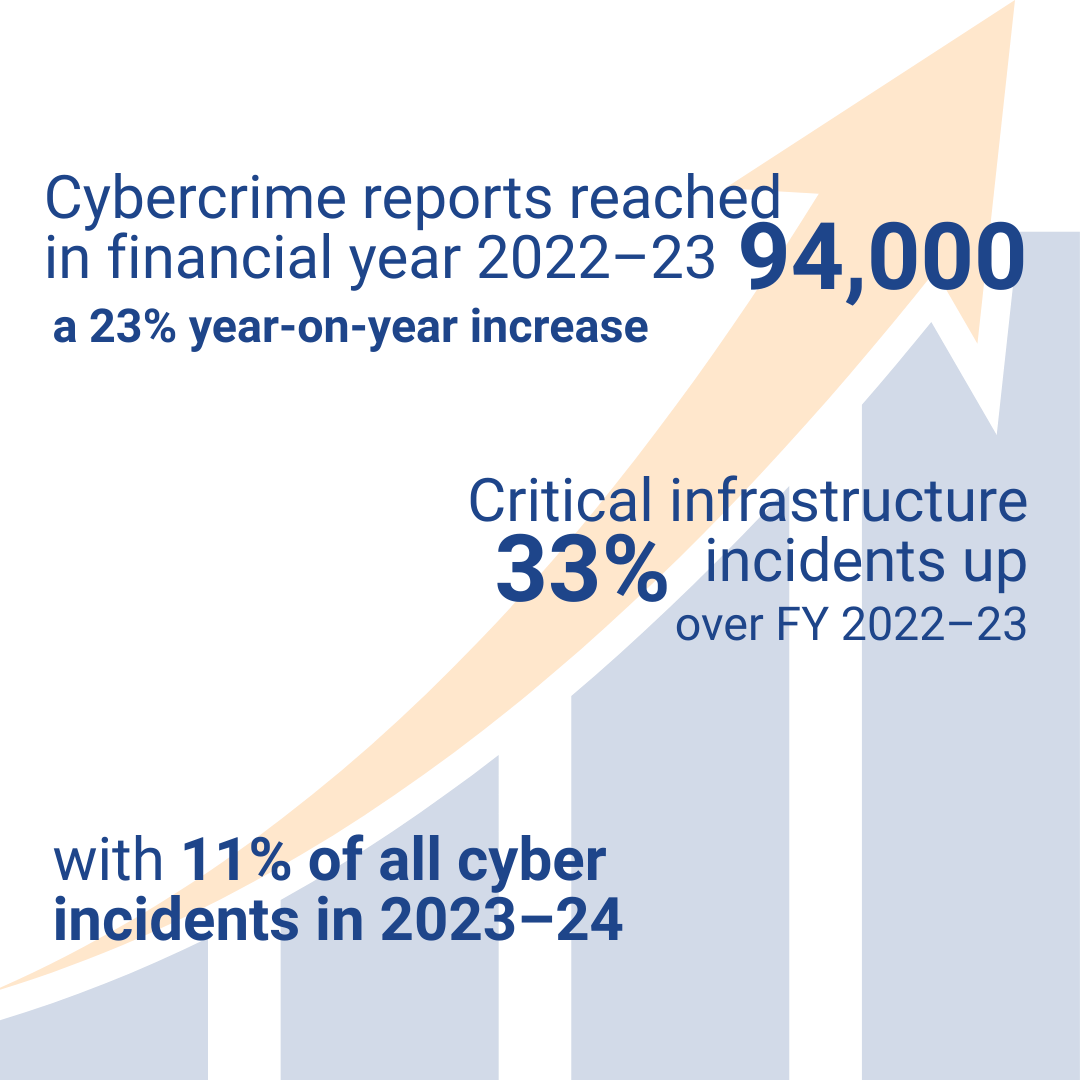
Secure every Click, Protect Every Connection
CYBER SECURITY
CYBER RISKS ARE RISING: WHAT EVERY AUSTRALIAN BUSINESS SHOULD KNOW
Breaches are increasing. Impacts are deepening. Here’s what the latest data reveals, and why no one can afford to look away.
The numbers speak for themselves. Cyber incidents are increasing in frequency, impact, and cost. From credential compromise to ransomware and business email scams, the threat landscape is expanding quickly. For today’s businesses, cyber security is not just a protective layer. It is a critical business function that supports trust, resilience, and continuity.
CYBER THREATS ARE ESCALATING
The past 12 months have seen consistent increases in the volume and severity of reported cyber incidents across Australia.
Cybercrime reports for the 2022–23 financial year reached 94,000, showing a 23% year-on-year increase. Critical infrastructure was a major target, with a 33% rise in reported incidents compared to the previous year. These trends show that cyber threats are growing not only in frequency but in reach.
The most common attack methods are also the easiest to underestimate. Phishing emails are growing more convincing, ransomware strains more destructive, and credential theft often goes undetected until it's too late.
What ties them together is this: They all thrive on gaps in everyday habits and systems. Multi-factor authentication, backup readiness, and user awareness aren’t optional anymore. They’re foundational.
THE BIGGEST THREATS
BUSINESS AND ECONOMIC IMPACT
Cybercrime doesn’t just affect IT. It affects cash flow, customer trust, and your ability to stay operational. What used to be a back-office risk now poses front-line consequences. And it's not just big businesses taking the hit. SMEs (small and midsize enterprises) are reporting significant losses that can take months or years to recover from. A single compromised invoice or exposed credential can cost far more than a full-year security solution.
Cyber incidents aren’t just technical setbacks — they’re financial events. Whether it’s a single compromised email or a full ransomware attack, the financial damage can be significant and long-lasting.
In the 2022–23 financial year, Australian businesses reported:
$46,000 to $49,600 average losses for small businesses
$97,200 average losses for medium-sized businesses
Over $55,000 average loss per Business Email Compromise (BEC) incident
More than $84 million in total national BEC losses
These aren’t just numbers. They represent lost productivity, client trust, and business continuity. The cost of cybercrime goes beyond IT and touches every part of a business:
Sales delays and cancelled contracts
Legal and compliance costs
Damaged brand reputation
Time and resources spent recovering
For most businesses, prevention is not only safer. It’s far more cost-effective than recovery.
That’s over a month where attackers had access, often without anyone knowing. By contrast, sectors like healthcare and finance detected and reported most incidents within the same 30-day window, minimising damage and regulatory exposure.
Why does this matter?
The first hours after a breach are critical
Slow responses increase legal risk and public fallout
Early detection can contain the threat before it spreads
If your systems aren’t monitored continuously or your team isn’t prepared to act, a small incident can turn into a major crisis fast.
One of the most overlooked aspects of cyber security is response time. The longer a breach goes undetected, the greater the damage, and the harder it is to recover.
In the second half of 2024:
74% of public sector breaches took more than 30 days to detect
66% of those also took over 30 days to report
WHY TIME IS A CRITICAL FACTOR IN BREACH RESPONSE
Australia’s national cyber security strategy is a strong signal that threats are being taken seriously at a policy level, but businesses still need to implement their own defences. Government can provide frameworks and funding, but it’s up to organisations to put practical protections in place.
This is where Click and Connect steps in, translating national priorities into local, actionable solutions for SMEs.
GOVERNMENT RESPONSE AND RESILIENCE
AUSTRALIA CYBER SECURITY STRATEGY
2023 - 2030
Aims to strengthen SME protection, critical infrastructure, and supply chain resilience
NEW RANSOMWARE PLAYBOOK
released in late 2024 warns:
63% of those attacked
who pay don’t recover data
released in late 2024 warns:
29% of victims
are targeted again
The latest ransomware data shows what many already suspect: paying the ransom often doesn't work. Even when data is recovered, the cycle usually repeats because the underlying vulnerabilities were never addressed. Prevention remains the only reliable strategy. That means having secure backups, system visibility, employee training, and trusted support before a breach happens, not scrambling afterward.
The statistics on this page reveal more than just numbers. They reflect a changing environment where threats are becoming more targeted, more sophisticated, and more frequent. For every business, from startups to established enterprises, awareness is only the beginning. Building strong cyber defences is what supports long-term resilience, protects trust, and keeps operations running when it matters most.
WHAT IT MEANS FOR YOUR BUSINESS
Learn how Click and Connect helps businesses stay protected with reliable, tailored cyber security support.
-
Office of the Australian Information Commissioner (OAIC), 2024, Notifiable Data Breaches Report: July to December 2023, viewed 29 July 2025,
https://www.oaic.gov.au/__data/assets/pdf_file/0021/156531/Notifiable-data-breaches-report-July-to-December-2023.pdf.
Australian Signals Directorate (ASD), 2023, Annual Cyber Threat Report 2022–23, viewed 29 July 2025,
https://www.cyber.gov.au/sites/default/files/2023-11/asd-cyber-threat-report-2023.pdf.Report Cyber & Australian Cyber Security Centre (ACSC), 2023, Report Cyber Annual Statistics 2022–23, viewed 29 July 2025,
https://www.cyber.gov.au/acsc/report.Netskope Threat Labs, 2024, Cloud and Threat Report 2024, viewed 29 July 2025,
https://www.netskope.com/netskope-threat-labs/cloud-threat-report/cloud-and-threat-report-2024.Zscaler ThreatLabz, 2024, ThreatLabz 2024 Ransomware Report, viewed 29 July 2025,
https://www.zscaler.com/blogs/security-research/threatlabz-ransomware-report-unveiling-75m-ransom-payments.Department of Home Affairs, Australian Government, 2023, Australia Cyber Security Strategy 2023–2030, Commonwealth of Australia, Canberra.
Reuters, 2024, Australia critical infrastructure faces cyber threats, report says, viewed 29 July 2025,
https://www.reuters.com/technology/cybersecurity/australia-critical-infrastructure-faces-cyber-threats-report-says-2024-11-20/.Herald Sun, 2024, ‘Victorians among most vulnerable to cyber attacks’, Herald Sun, 31 July, viewed 29 July 2025,
https://www.heraldsun.com.au/leader/1-in-4-australian-cyber-attacks-hit-victorians-data-finds/news-story/ac92ae7cae4fa647b0c8e84b0a5fde2d.The Australian, 2024, Cyber threats continue to escalate across Australia (full citation unavailable).











